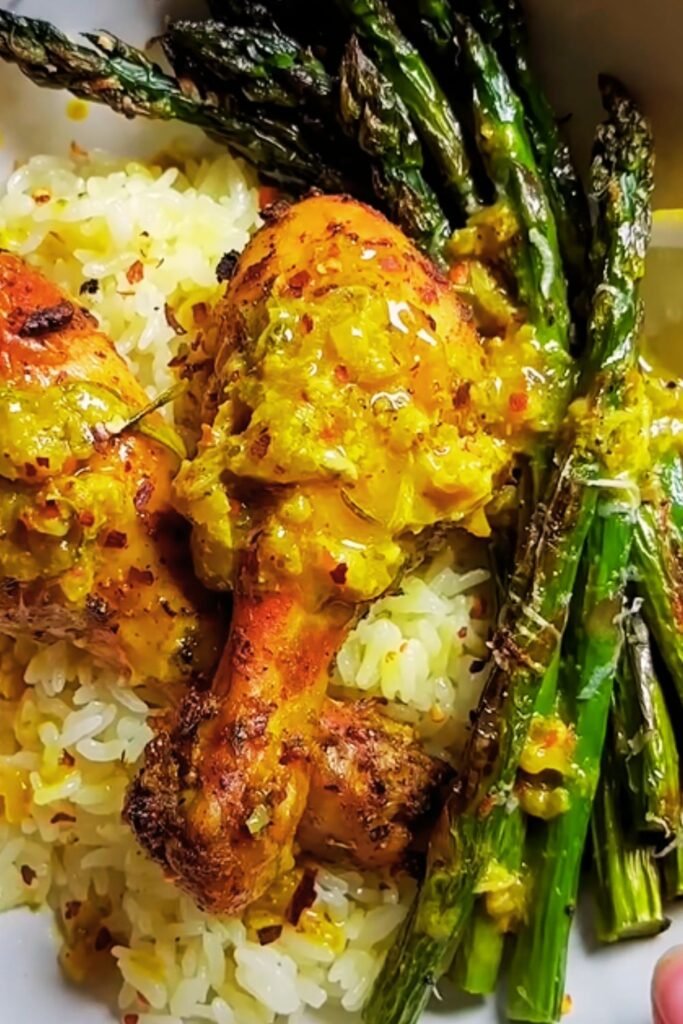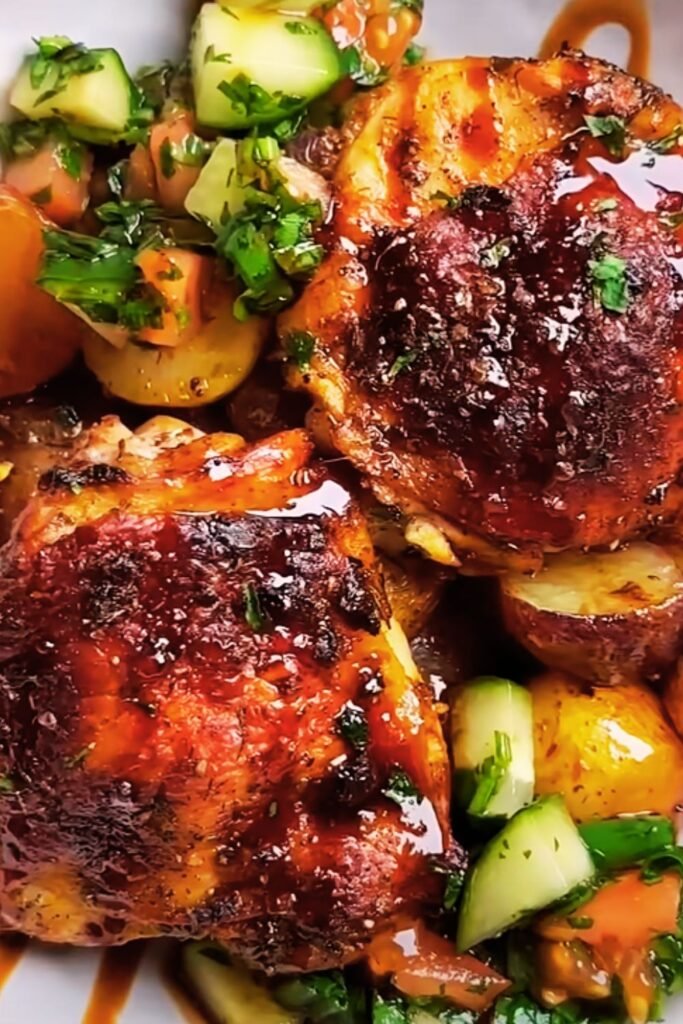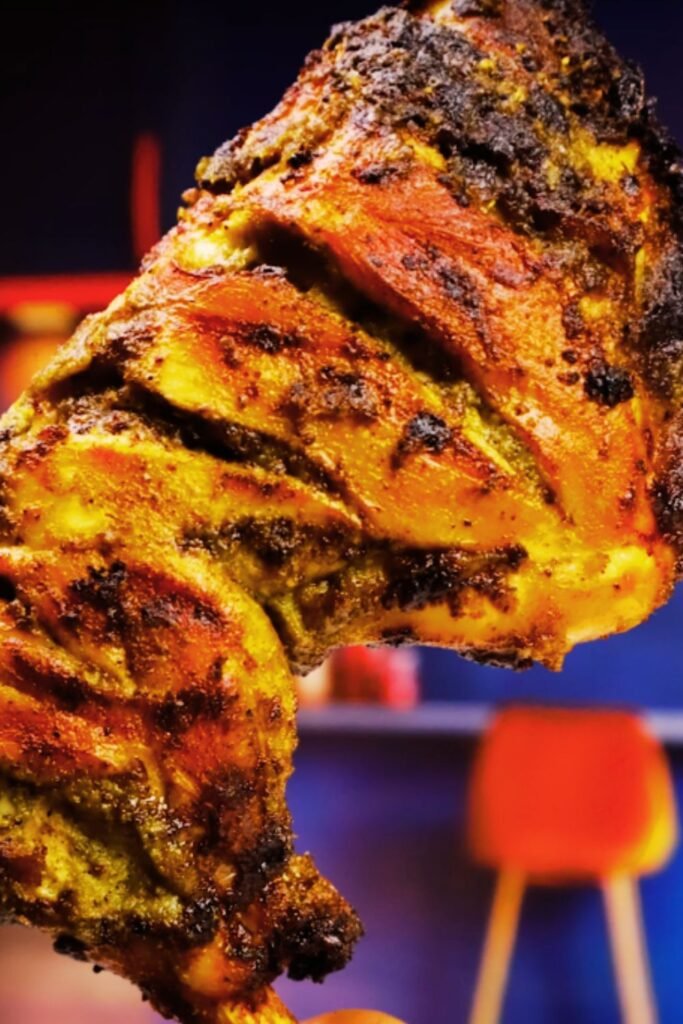There’s something magical about the combination of sweet apples and savory chicken that creates an irresistible harmony on your taste buds. As someone who’s been cooking family dinners for over 15 years, I’ve perfected this Apple Chicken Skillet recipe through countless iterations. It’s become my go-to dish when I need something impressive yet simple enough for busy weeknights. The warm spices, tender chicken, and caramelized apples create a symphony of flavors that will have everyone asking for seconds.
Why You’ll Love This Recipe
I remember the first time I made this dish for my family—the kitchen filled with the aroma of cinnamon and apples, creating an atmosphere of warmth and comfort even before the first bite. What makes this recipe special is its perfect balance between ease and elegance. It’s simple enough for kitchen beginners but sophisticated enough to serve to guests.
Here’s why this Apple Chicken Skillet deserves a spot in your regular rotation:
- One-pan wonder: Everything cooks in a single skillet, meaning fewer dishes and less cleanup
- Ready in 30 minutes: Perfect for busy weeknights when time is precious
- Nutritionally balanced: Protein from chicken, fiber from apples, and a reasonable amount of healthy fats
- Customizable: Easily adapted to what you have on hand or seasonal ingredients
- Kid-friendly: The natural sweetness from the apples appeals to younger palates
- Impressive presentation: Looks like you spent hours, when it actually takes minutes
Ingredients You’ll Need

For this Apple Chicken Skillet, I’ve carefully balanced each ingredient to create a perfect harmony of flavors. Here’s what you’ll need to serve 4 people:
For the Chicken:
- 1½ pounds boneless, skinless chicken breasts (about 3-4 breasts)
- 2 tablespoons olive oil
- 1 teaspoon kosher salt
- ½ teaspoon freshly ground black pepper
- 1 teaspoon dried thyme
- ½ teaspoon ground cinnamon
- ¼ teaspoon ground nutmeg
- 1 tablespoon unsalted butter
For the Apple Mixture:
- 3 medium apples (I prefer Honeycrisp or Braeburn), cored and sliced ¼-inch thick
- 1 large sweet onion, thinly sliced
- 2 cloves garlic, minced
- 1 tablespoon fresh sage, chopped (or 1 teaspoon dried)
- ¾ cup low-sodium chicken broth
- 2 tablespoons pure maple syrup (not pancake syrup)
- 1 tablespoon apple cider vinegar
- ¼ cup heavy cream (optional, for a richer sauce)
For Garnish:
- 2 tablespoons fresh parsley, chopped
- ¼ cup toasted pecans or walnuts, roughly chopped (optional)
- Extra fresh sage leaves
Kitchen Equipment Needed
I’ve found that the right tools make this recipe even easier to prepare:
- 12-inch cast iron skillet (preferred) or heavy-bottomed skillet
- Sharp chef’s knife
- Cutting board
- Measuring spoons and cups
- Wooden spoon or silicone spatula
- Meat thermometer
- Tongs for flipping chicken
Step-by-Step Instructions
Preparing the Chicken
- Prepare the chicken: If your chicken breasts are very thick, place them between two sheets of plastic wrap and pound to an even thickness of about ¾ inch. This ensures even cooking.
- Season generously: In a small bowl, mix together the salt, pepper, dried thyme, cinnamon, and nutmeg. Pat the chicken dry with paper towels (this helps achieve a better sear), then season both sides of the chicken with this spice mixture.
- Heat your skillet: Place your cast iron skillet over medium-high heat and add the olive oil. When the oil is shimmering but not smoking, it’s ready.
- Sear the chicken: Add the chicken breasts to the hot skillet without overcrowding (you may need to work in batches). Sear for 4-5 minutes on each side until golden brown and nearly cooked through (internal temperature should reach 155°F as it will continue cooking later).
- Set aside: Transfer the chicken to a clean plate and tent loosely with foil to keep warm. Don’t clean the skillet – those browned bits are flavor gold!
Creating the Apple Mixture

- Sauté the onions: In the same skillet, add the tablespoon of butter. Once melted, add the sliced onions with a pinch of salt. Cook over medium heat for about 5 minutes until they begin to soften and turn translucent.
- Add garlic and apples: Add the minced garlic and cook for 30 seconds until fragrant. Then add the sliced apples and sage, stirring to coat everything in the pan drippings.
- Develop flavor: Cook the apple mixture for about 5-7 minutes, stirring occasionally, until the apples begin to soften but still hold their shape. You want them tender but not mushy.
- Deglaze the pan: Pour in the chicken broth, maple syrup, and apple cider vinegar, using a wooden spoon to scrape up any browned bits from the bottom of the pan. These bits contain concentrated flavor that will enhance your sauce.
- Reduce the sauce: Allow the liquid to come to a simmer, then reduce heat to medium-low and cook for 2-3 minutes until slightly reduced.
- Add cream (if using): If you’re using heavy cream, stir it in now and simmer for another minute until the sauce thickens slightly.
Bringing It All Together
- Return the chicken: Nestle the chicken breasts back into the skillet, along with any accumulated juices.
- Finish cooking: Cover the skillet (if you don’t have a lid, foil works in a pinch) and cook on medium-low for another 3-5 minutes, or until the chicken reaches an internal temperature of 165°F and is fully cooked.
- Rest before serving: Remove the skillet from heat and let it rest for 5 minutes. This allows the flavors to meld and the juices to redistribute throughout the chicken.
- Garnish: Sprinkle with fresh parsley and toasted nuts if using. Add a few fresh sage leaves for an extra touch of elegance.
Nutritional Information
I believe in knowing what goes into my body, so here’s a breakdown of the nutritional content per serving (based on 4 servings):
| Nutrient | Amount |
|---|---|
| Calories | 425 |
| Protein | 38g |
| Carbohydrates | 25g |
| Dietary Fiber | 4g |
| Sugars | 18g |
| Fat | 18g |
| Saturated Fat | 6g |
| Cholesterol | 115mg |
| Sodium | 680mg |
| Potassium | 890mg |
| Vitamin A | 15% DV |
| Vitamin C | 12% DV |
| Calcium | 6% DV |
| Iron | 10% DV |
Note: Nutritional values are approximate and may vary based on specific ingredients used.
Variations and Substitutions
Over the years, I’ve experimented with numerous variations of this recipe. Here are some of my favorite substitutions that work beautifully:
Different Proteins:
- Turkey cutlets (reduce cooking time by about 2 minutes per side)
- Pork chops (adjust cooking time based on thickness)
- Firm tofu slices for a vegetarian option (press well and sear 3-4 minutes per side)
Apple Varieties:
- Granny Smith: For a more tart flavor profile
- Gala or Fuji: For extra sweetness
- Pink Lady: For a perfect balance between sweet and tart
Seasonal Twists:
- Fall version: Add 1 tablespoon of pumpkin pie spice and a handful of dried cranberries
- Winter holiday: Include a cinnamon stick and star anise while simmering
- Spring variation: Add asparagus pieces during the last 5 minutes of cooking
- Summer delight: Add 1 cup of fresh berries when you return the chicken to the pan
Dietary Adaptations:
| Dietary Need | Substitution |
|---|---|
| Dairy-free | Use coconut oil instead of butter and coconut cream instead of heavy cream |
| Gluten-free | Already gluten-free! Just ensure your chicken broth is certified gluten-free |
| Lower carb | Reduce maple syrup to 1 teaspoon and use only 1 apple, adding more onions |
| Paleo | Use ghee instead of butter, coconut cream instead of heavy cream, and omit maple syrup (use a bit of honey if desired) |
Make-Ahead and Storage Tips
I’m all about meal prep and making dinner time easier. Here’s how to work with this recipe for maximum convenience:
Prep Ahead:
- Slice and dice: Prepare all your ingredients up to 24 hours in advance. Store sliced apples in water with a squeeze of lemon juice to prevent browning.
- Pre-season chicken: Mix the spice blend and season the chicken up to 12 hours ahead. Store covered in the refrigerator to allow the flavors to penetrate.
- Partially cook: You can sear the chicken and cook the onions separately, then refrigerate. Finish the dish with the apples and sauce just before serving (add 5 minutes to final cooking time).
Storage:
- Refrigerator: Store leftovers in an airtight container for up to 3 days.
- Freezer: While the texture of the apples will change somewhat, you can freeze this dish for up to 2 months. Thaw overnight in the refrigerator before reheating.
Reheating:
- Stovetop: For best results, reheat gently in a covered skillet over medium-low heat with a splash of chicken broth to maintain moisture.
- Microwave: Cover and heat at 70% power in 30-second intervals, stirring between each, until heated through.
- Oven: Place in an oven-safe dish, cover with foil, and heat at 325°F for about 15 minutes or until warmed through.

Serving Suggestions
When I serve this Apple Chicken Skillet, I like to create a complete meal that complements the sweet and savory flavors. Here are my favorite pairings:
Perfect Side Dishes:
- Creamy mashed potatoes or cauliflower
- Wild rice pilaf with herbs
- Roasted Brussels sprouts with a drizzle of balsamic glaze
- Simple green salad with light vinaigrette
- Crusty whole grain bread for soaking up the delicious sauce
For a Special Occasion:
- Start with a butternut squash soup
- Serve alongside roasted root vegetables
- Finish with a warm apple crisp for dessert (double down on those apple flavors!)
Casual Weeknight Meal:
- Quinoa or couscous (cooks in just 15 minutes)
- Steamed green beans with a squeeze of lemon
- Quick cucumber salad with dill
Breakfast Twist:
Yes, I’ve even repurposed leftovers for breakfast! Dice the leftover chicken and apples, heat in a skillet, and serve with a fried egg on top. Absolutely delicious!
Recipe FAQs
Over the years, I’ve been asked numerous questions about this recipe. Here are the most common ones:
Q: Why did my apples turn mushy? A: Most likely they were cooked too long or the heat was too high. Different apple varieties have different cooking times – firmer apples like Honeycrisp, Braeburn, and Granny Smith hold their shape better during cooking. Also, make sure your apple slices aren’t cut too thin.
Q: Can I make this in a slow cooker? A: Yes, though the texture will be different. Sear the chicken first, then place in the slow cooker with all other ingredients except the cream. Cook on low for 4 hours, then stir in cream during the last 15 minutes.
Q: Is there a way to make the sauce thicker? A: For a thicker sauce, you can either reduce it longer before adding the chicken back in, or make a slurry with 1 teaspoon cornstarch mixed with 1 tablespoon cold water. Add this to the simmering sauce before returning the chicken.
Q: My chicken came out dry. What went wrong? A: The most common cause is overcooking. Remember that chicken continues to cook slightly after you remove it from heat. Use a meat thermometer and remove the chicken when it reaches 160-165°F. Also, pounding the chicken to an even thickness helps prevent dry edges while waiting for thicker parts to cook.
Q: Can I use boneless chicken thighs instead? A: Absolutely! Chicken thighs are more forgiving and stay juicier. The cooking time will be similar, but always check with a meat thermometer to ensure they reach 165°F.
Q: How do I prevent the spices from burning in the pan? A: If you notice the spices beginning to darken too quickly, lower the heat. You can also try adding the spices to the chicken after you’ve already begun searing one side, which gives them less time in the pan.
Q: My family doesn’t like sage. What can I substitute? A: Thyme works beautifully as an alternative, or you could try rosemary for a different but complementary flavor profile. Fresh tarragon would also work well with the apple flavor.
Chef’s Tips for Success
After making this recipe countless times, I’ve developed some tricks to take it from good to exceptional:
- Temperature matters: Start with room temperature chicken for more even cooking. Take it out of the refrigerator about 20 minutes before you plan to cook.
- Don’t rush the sear: A good golden crust on the chicken not only looks appealing but adds tremendous flavor. Don’t flip too early – when the chicken is properly seared, it will release easily from the pan.
- Apple selection strategy: If mixing apple varieties, add firmer ones like Granny Smith first, then more tender varieties like Gala a few minutes later.
- Layered seasoning: Season at every stage – the chicken, the onions, and again when tasting the final sauce. This creates depth of flavor.
- The power of deglazing: When adding the liquids, take time to scrape up all the browned bits from the bottom of the pan. This is where much of your flavor resides.
- Sauce consistency test: The sauce should coat the back of a spoon. Run your finger through it – if the line holds, your sauce is the perfect consistency.
- Rest before serving: This step is non-negotiable! Letting the dish rest for 5 minutes allows the chicken to reabsorb juices and the flavors to harmonize.
Why This Recipe Works
I’ve spent years refining this recipe, and there’s food science behind why it works so well:
- The maillard reaction: Searing the chicken creates hundreds of new flavor compounds through this chemical reaction between amino acids and reducing sugars.
- Flavor balancing: The acidity from the apple cider vinegar balances the sweetness from the apples and maple syrup, while the herbs add aromatic complexity.
- Temperature control: The initial high-heat sear followed by a gentle finish ensures juicy chicken without overcooking.
- The power of fond: Those browned bits stuck to the pan after searing (called fond) dissolve into the sauce, adding rich umami flavor.
- Complementary textures: Tender chicken, softened but still structured apples, and silky sauce create a satisfying mouthfeel with every bite.
This Apple Chicken Skillet has become my signature dish for good reason – it strikes that perfect balance between sophisticated flavor and comforting familiarity. It’s the recipe I’m most often asked to share, and I’m confident it will become a favorite in your home too.
Q&A Section
Q: What’s the best type of apple to use in this recipe? A: I prefer firm, sweet-tart apples like Honeycrisp, Braeburn, or Pink Lady because they hold their shape well during cooking while providing balanced flavor. Granny Smith works well if you prefer a more tart profile, while Gala or Fuji adds extra sweetness. Avoid softer varieties like McIntosh which break down too quickly.
Q: Can I make this recipe ahead for a dinner party? A: Yes! You have two options: either fully cook it up to 2 days ahead and gently reheat (adding a splash of chicken broth), or prep all components separately (sear the chicken, prepare the apple mixture) and assemble just before serving. The latter method gives the freshest results but requires more last-minute work.
Q: How can I tell when the chicken is perfectly cooked? A: The most reliable method is using an instant-read thermometer inserted into the thickest part of the breast – it should read 165°F. Visually, the juices should run clear (not pink), and when you cut into it, the meat should be opaque white throughout with no pink areas.
Q: My sauce split and looks curdled. How can I fix it? A: This can happen if the cream is added to a mixture that’s too hot or acidic. To fix it, remove from heat and whisk in 1-2 tablespoons of cold chicken broth. To prevent splitting, ensure your pan isn’t too hot when adding cream and consider tempering the cream by mixing a little of the hot sauce into it before adding it to the pan.
Q: Can I double this recipe for a larger crowd? A: Absolutely, though you’ll need either a very large skillet (14+ inches) or to work in batches. I recommend cooking the chicken in batches to avoid overcrowding, which prevents proper browning. You can then combine everything in a larger pot or baking dish for the final simmer together.
Q: How do I adapt this for my picky kids who don’t like “mixed foods”? A: Try separating the components – plain seared chicken (using just salt and pepper), apples sautéed with cinnamon and a touch of maple syrup, and serve plain rice or potatoes on the side. As they get more adventurous, you can gradually introduce the full combined dish.
Q: What’s the secret to getting that perfect caramelization on the apples without them turning to mush? A: Three key factors: 1) High enough heat at the beginning to trigger caramelization, 2) Not stirring too frequently, which gives them time to develop color, and 3) Using firm apple varieties. I also find that slicing them a bit thicker (about ¼ inch) helps them maintain structure while still cooking through.